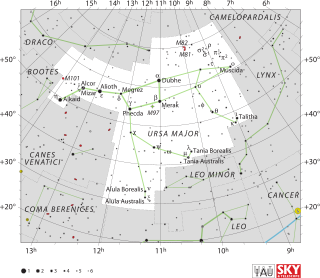Iota Ursae Majoris (ι Ursae Majoris, abbreviated Iota UMa, ι UMa), also named Talitha /ˈtælɪθə/,[14] is a star system in the northern circumpolar constellation of Ursa Major. It has an apparent visual magnitude of 3.14,[2] making it visible to the naked eye and placing it among the brighter members of this constellation. Based upon parallax measurements, it is located at a distance of 47.3 light-years (14.5 parsecs) from the Sun.
- ^ a b c d e Cite error: The named reference
aaa474_2_653was invoked but never defined (see the help page). - ^ a b c d Cite error: The named reference
clpl4was invoked but never defined (see the help page). - ^ a b Cite error: The named reference
simbadwas invoked but never defined (see the help page). - ^ a b c d e f Cite error: The named reference
Zhuchkov2012was invoked but never defined (see the help page). - ^ Cite error: The named reference
rgcrvwas invoked but never defined (see the help page). - ^ Cite error: The named reference
Anderson2012was invoked but never defined (see the help page). - ^ "Sixth Catalog of Orbits of Visual Binary Stars". United States Naval Observatory. Archived from the original on 1 August 2017. Retrieved 16 May 2017.
- ^ a b c Cite error: The named reference
gasparwas invoked but never defined (see the help page). - ^ Cite error: The named reference
draperwas invoked but never defined (see the help page). - ^ Cite error: The named reference
aaa463_2_671was invoked but never defined (see the help page). - ^ Cite error: The named reference
apj653_1_675was invoked but never defined (see the help page). - ^ Cite error: The named reference
kirkpatrickwas invoked but never defined (see the help page). - ^ a b Cite error: The named reference
predictedwas invoked but never defined (see the help page). - ^ "IAU Catalog of Star Names". Retrieved 28 July 2016.
